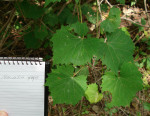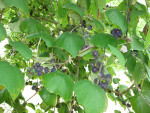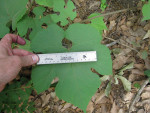WILD TEXAS GRAPES
By Christine Morgan, ND and Master Gardener
Here in Texas, there are two main types of wild grapes. Many people think all wild grapes are the same, but that isn’t true. The important thing to know is that most parts of these two grape plants…the tendrils, leaves, and fruit are edible.
The first is the Muscadine grape. It has a solid leaf shape that ends in a point with a few ridges around the edges. Its scientific name is Vitis rotundiflora.
It ripens in August to September and is usually in East Texas. The leaves are used in vegetable fermenting and to make dolmas (stuffed grape leaves) and other dishes with grape leaves. The fruit makes jelly or jam. They are slightly sweeter that Mustang grapes.
The second is the Mustang grape. The shape of its leaf looks like three fat fingers and a hand, but more correctly called a 3 lobed leaf. As the leaf matures through the summer, it fills
in and looks much like other grape leaves. Also it is white underneath and somewhat fuzzy looking unlike the Muscadine leaf. Its scientific name is Vitis mustangensis. It ripens in Mid-July. Mine ripened on the dot this year, July 15th. Mustang grapes are quite acid
and may make your hands itch or burn for a while after handling. I use small pruners to clip the grapes and a little stem from the vines with no problem. After washing and preparing is when they might bite you a bit. No worries…it goes away with soap and coconut oil rubbed in to your hands.
To store:
I fill my sink with cold water and 2 capfuls of a vegetable wash called FIT. Let them soak a few minutes to make sure there is no highway, pesticide or dirt junk on them. Rinse thoroughly. Next, I pull the stems off from the grapes. If you only want juice to make jelly, you can leave them on. If I’m not making jelly-jam now (because I’m too tired and hot from picking), I put them in gallon bags and freeze them for another day. FYI- they do not do well at room temperature or even refrigerated for more than a day, and even then you can tell they are changing, hence why I pick, clean, and freeze them.
Here is my recipe for Mustang grape jelly/jam… It is really a cross between jelly and jam.
Mustang Jelly-Jam
4-5 cups juice and pulp
1 box Sure-Gel pectin
½ teaspoon unsalted butter
7 cups organic sugar
Hot, sterilized 4 oz. or 8 oz. jelly jars, with lids and rings.
Prep work:
Clean and fill water bath canner with empty jars, lids and rings. Bring to boil and simmer for 10 minutes; then turn off heat and leave lid on to stay warm.
Make the juice:
- Put fresh or frozen grapes (1-2 gallon Ziploc bags) in large stockpot with 1 cup of water. Bring them to a simmer. I look for no solid grapes in pot to know if they are done (about 20 minutes). Turn off heat and let sit for 20 minutes.
- Strain the juice and pulp through a mesh strainer or metal colander into a large bowl. Taste and if extremely acid, add 1 teaspoon of baking soda.
- Wash your stock pot and dry, or use another one if you have it.
Makin’ Jelly-Jam:
- Remove jars, lids, and rings and dry. Leave jars upside down until time to fill them on clean towel. Leave water in canner.
- Measure 4-5 cups of juice/pulp into a stockpot. Add ½ t. butter and 1 box of Sure-Gel and bring to boil. Add 7 cups of sugar and bring to rolling boil…boil for 1 minute exactly after it starts a rolling boil (I use a timer). TURN OFF gas heat or move to another burner if you have an electric stove. Note: Do not try to double this recipe, it won’t work. Instead make it batch by batch if you are swimming in grape juice.
- Use canning ladle to fill jars, leaving ½ inch headspace. Fit with lids and rings and tighten.
Load water bath canner rack with jars. Lower into canner and add hot tap water if necessary to cover jars by 2 inches. Bring to a boil and simmer for 5 minutes on timer.
Remove to counter and let cool completely. Check lids for sealing. If it pops up and down…it’s not sealed. Refrigerate and use ASAP.
Label and store in pantry or give as gifts. Enjoy!
Sources: Texas A & M Agri-Life
Ball Canning guide 2014




[…] Wild Texas Grapes […]